This Acushnet Golf Ball Design Will Wrinkle Your Brain
Golf ball patents and patent applications are generally one of two types. First, the most common type is directed to the complex composition of one or more layers of the ball, and you generally need an advanced degree in chemistry or polymer engineering to make heads or tails of what has been invented. The second type is directed to the general construction of the ball, often with emphasis on the surface pattern and the related aerodynamics; these are the applications that I find fascinating and are something that the average golfer can appreciate.
Lately there has been a trend toward golf ball patent applications directed to improving the aerodynamics of the ball with some rather unconventional surface patterns; and I call them “surface patterns” because they are just too far removed from what most golfers think of as a dimple. In fact, you may recall THIS recent post in which I questioned if the traditional dimple has reached the end of its useful life. Well, today an aerodynamic golf ball patent application was published that discloses a golf ball that is probably unlike anything you could have imagined. Check out this golf ball disclosed in an Acushnet patent application that became public this week.
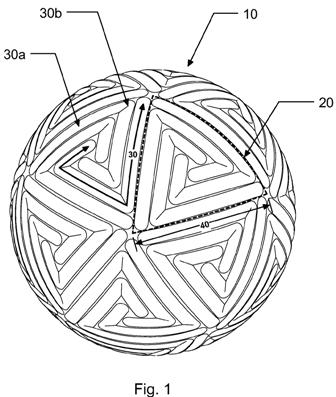

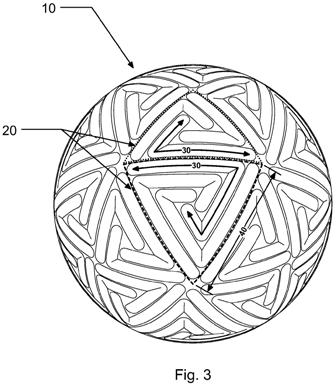
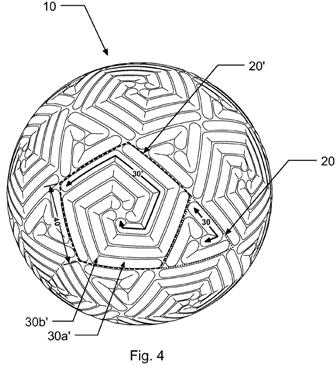
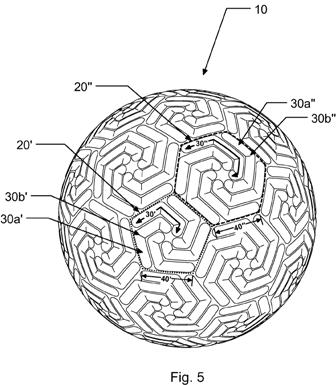

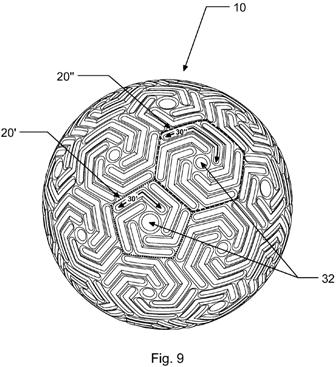
The designs come from a patent application that published as US Pub. No. 20100069176 titled “Golf Ball with Polygonal Dimple Groupings,” which explains:
The present invention concerns a golf ball having dimple groupings comprised of multiple angular spiral shaped arms that are arrayed to form polygonal perimeters, wherein the number of arms equals the number of perimeter sides. This allows greater symmetry about the dimple grouping center, thereby improving the consistency of the aerodynamic performance of the ball. In another unique feature of the present invention, the angular shape of the arms facilitates the formation of polygonal shaped dimple groupings, which can fit closely together to cover a greater proportion of the ball’s surface, preferably more than about 85% surface coverage, thereby further enhancing aerodynamic performance.
BACKGROUND OF THE INVENTION
[0002] Golf balls generally include a spherical outer surface with a plurality of dimples formed thereon. Conventional dimples are circular depressions that reduce drag and increase lift. These dimples are formed where a dimple wall slopes away from the outer surface of the ball forming the depression.
[0003] Drag is the air resistance that opposes the golf ball’s flight direction. As the ball travels through the air, the air that surrounds the ball has different velocities thus, different pressures. The air exerts maximum pressure at a stagnation point on the front of the ball. The air then flows around the surface of the ball with an increased velocity and reduced pressure. At some separation point, the air separates from the surface of the ball and generates a large turbulent flow area behind the ball. This flow area, which is called the wake, has low pressure. The difference between the high pressure in front of the ball and the low pressure behind the ball slows the ball down. This is the primary source of drag for golf balls.
[0004] The dimples on the golf ball cause a thin boundary layer of air adjacent to the ball’s outer surface to flow in a turbulent manner. Thus, the thin boundary layer is called a turbulent boundary layer. The turbulence energizes the boundary layer and helps move the separation point further backward, so that the layer stays attached further along the ball’s outer surface. As a result, a reduction in the area of the wake, an increase in the pressure behind the ball, and a substantial reduction in drag are realized. It is the circumference of each dimple, where the dimple wall drops away from the outer surface of the ball, which actually creates the turbulence in the boundary layer.
[0005] Lift is an upward force on the ball that is created by a difference in pressure between the top of the ball and the bottom of the ball. This difference in pressure is created by a warp in the airflow that results from the ball’s backspin. Due to the backspin, the top of the ball moves with the airflow, which delays the air separation point to a location further backward. Conversely, the bottom of the ball moves against the airflow, which moves the separation point forward. This asymmetrical separation creates an arch in the flow pattern that requires the air that flows over the top of the ball to move faster than the air that flows along the bottom of the ball. As a result, the air above the ball is at a lower pressure than the air underneath the ball. This pressure difference results in the overall force, called lift, which is exerted upwardly on the ball. The circumference of each dimple is important in optimizing this flow phenomenon, as well.
[0006] By using dimples to decrease drag and increase lift, almost every golf ball manufacturer has increased their golf ball flight distances. In order to optimize ball performance, it is desirable to have a large number of dimples, hence a large amount of dimple circumference, which is evenly distributed around the ball. In arranging the dimples, an attempt is made to minimize the space between dimples, referred to herein as “land area,” because the land area does not improve aerodynamic performance of the ball. In practical terms, this usually translates into 300 to 500 circular dimples with a conventional sized dimple having a diameter that typically ranges from about 0.100 inches to about 0.180 inches.
[0007] One attempt to improve the aerodynamic performance of golf balls is suggested in U.S. Pat. No. 6,162,136 (“the ‘136 patent”), assigned to the Acushnet Company, wherein a preferred solution is to minimize the land surface or undimpled surface of the ball. The ‘136 patent also discloses that this minimization should be balanced against the durability of the ball. Since as the land surface decreases, the susceptibility of the ball to premature wear and tear by impacts with the golf club increases.
[0008] Another attempt to improve the aerodynamic performance of golf ball is suggested in commonly owned U.S. patent application Ser. No. 11/738,755 (“the ‘755 application”), which discloses a golf ball comprising a plurality of dimple groupings comprising one or more spiral shaped depressions with a single smoothly curved arm. The spiral shaped depressions are arrayed to form a generally rounded or circular perimeter shape. With such circular dimple groupings, golf ball surface coverage is typically limited to a maximum of about 85%. The ‘755 application does disclose generally polygonal perimeter shapes, i.e., a triangular dimple or a square dimple, with such groupings consisting of a polygonal depression with a single spiral depression superimposed inside.
[0009] Hence, there remains a need in the art for a golf ball with at least one non-circular dimple grouping that has a high dimple coverage and superior aerodynamic performance.
.
.
.
[0022] As illustrated in FIG. 1, the prese
nt invention concerns a golf ball 10 having dimple groupings 20 comprised of multiple angular spiral shaped arms 30 that are arrayed to form generally polygonal perimeters, wherein the number (n.sub.1) of arms 30 equals the number (n.sub.2) of perimeter sides 40. For example, a triangular dimple grouping 20, as shown in FIG. 1, has three arms 30 and three sides 40, and a square dimple grouping (not shown) would have four arms and four sides. The condition that the number of arms 30 should match the number of perimeter sides 40 is an innovative aspect of the present invention that allows greater symmetry about the dimple grouping center, thereby improving the consistency of the aerodynamic performance of the ball. In another unique feature of the present invention, the angular shape of arms 30 facilitates the formation of polygonal shaped dimple groupings 20, which can fit closely together to cover a greater proportion of the ball’s surface, preferably more than 80%, preferably more than about 85% and up to about 90% surface coverage, thereby further enhancing aerodynamic performance.
Pretty amazing stuff! Are the days of the traditional circular dimple numbered?
David Dawsey – Keeping an Eye on Golf Ball Inventions
PS – click HERE to read more interesting golf ball patent posts
